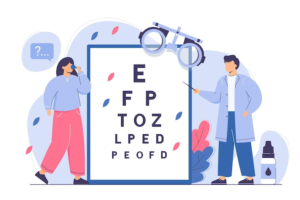
Vision Impairment Adwait
Vision Impairment Meaning

Embracing a World of Darkness: Understanding Vision Impairment
Vision impairment, also known as visual impairment or blindness, is a condition that affects millions of people worldwide. It can have a profound impact on one’s daily life, independence, and overall well-being. Understanding the causes, types, and consequences of vision impairment is crucial for promoting inclusivity, providing appropriate support, and advocating for accessibility. In this article, we will explore the world of vision impairment, shedding light on its causes, types, effects, and available solutions.
Understanding Vision Impairment:
What Causes Vision Impairment
Vision impairment can be caused by various factors, including eye diseases (such as cataracts, glaucoma, or macular degeneration), congenital conditions, injuries to the eyes or brain, and certain systemic diseases. Genetic factors can also play a role. Identifying the underlying cause is essential for appropriate treatment and management.
Types and Degrees of Vision Impairment:
Vision impairment can range from mild visual impairments to complete blindness. It is classified into two main categories: partial sight (low vision) and total blindness. Low vision refers to significant visual impairment that cannot be fully corrected with glasses, contact lenses, medication, or surgery. Total blindness refers to the absence of light perception. The degree of vision impairment can vary widely, and individuals may experience different levels of functional vision.
Effects on Daily Life and Independence:
Vision impairment can significantly impact one’s ability to perform daily tasks and navigate the world independently. Individuals with vision loss may face challenges in reading, recognizing faces, maneuvering in unfamiliar environments, and participating in activities that rely heavily on visual cues. It can affect educational and career opportunities, limit social interactions, and lead to a decreased quality of life. However, with appropriate support and accommodations, individuals with vision impairment can overcome these challenges and lead fulfilling lives.
Diagnosis and Treatment:
Diagnosing vision impairment involves a comprehensive eye examination and visual acuity testing. Early detection is crucial, as it allows for timely intervention and support. While there is no cure for many causes of vision impairment, various treatment options and assistive technologies can help individuals maximize their remaining vision and enhance their functional abilities. These may include visual aids, adaptive techniques, orientation and mobility training, and vocational rehabilitation programs.
Support and Accessibility:
Support systems and accessibility play a crucial role in the lives of individuals with vision impairment. Braille materials, screen readers, magnification devices, and audio descriptions for visual media can greatly enhance access to information and communication. Adaptive technology, such as talking watches, navigation apps, and tactile markers, can promote independence and participation in various activities. Education, workplaces, and public spaces should prioritize accessibility measures to ensure equal opportunities and inclusion for individuals with vision impairment.
Conclusion:
Vision impairment is a significant challenge for millions of people worldwide. By understanding its causes, types, and consequences, we can work towards creating a more inclusive society for individuals with vision loss. Early diagnosis, appropriate interventions, and accessibility measures are crucial in enabling individuals with vision impairment to lead independent and fulfilling lives. By promoting awareness, advocating for accessibility, and providing support, we can break down barriers and foster a world that embraces and celebrates the abilities and potential of individuals with vision impairment.
